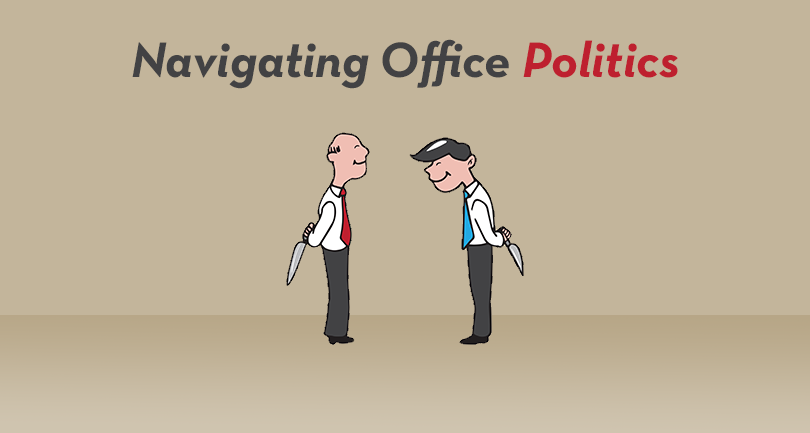
From our guest author Juan Ugarte!
For many people the subject of office politics is a tough topic. While we may not like it, most of us realize that office politics can either make their day-to-day work pleasant or dreary, expedite or delay a project, and sideline or slingshot a career.
Politics is merely the art of getting support.
If we look deeper into this simple fact, it would help navigating the labyrinth a lot easier for those who are challenged by it. The three areas of focus in this article will be the organizational culture, one to one relationships, and communication style.
Culture

I’ve worked in small & medium size design firms, nonprofits, colleges, restaurants, corporate offices, and startups. Each environment had its own unspoken code of behavior and a vocabulary that lent insight into it. Each one had a different set of values that either did or did not coincide with their mission. Look at the company or organization you are in now and compare their mission statement (if one exists) to what you observe being supported. If it doesn’t have a mission statement, that is something significant in and of itself. Some companies do not feel that a formal statement is necessary. Look for what they value. A mission statement that is consistent with what you observe in the daily environment will make this task easy. No mission statement? Look for common used slogans and clichés. They will reveal the mindset of the culture.
Understanding what motivates people who are the real power players is key. Observe what is supported and promoted versus what is ignored or shunned. Do they value good ideas or hard work? Getting along or getting it done? Bringing in more sales usually is valued over long hours at the office. But productivity may take a backseat to meeting etiquette. Take note of what is promoted and supported and it will go a long way toward getting that raise.
How do people dress? It’s subtle, but there is a reason why corporate executives adopted the same style no matter what country they were from. It makes it easier for a stranger seem like one of the natives. Working in startups is way different than corporate office. Sketchers vs Gucci footwear, jeans vs wool slacks. Adopt the general trend of what people are wearing to fit in while maintaining your own style.
Relationships
Take the corporate diagram and start to draw lines along actual interactions between the entities. If you’re wondering how to do this it’s pretty simple: see who spends time with who at the water cooler, who goes out to lunch together and who is spends time socially. That diagram is the real map of relationships. Once again, observe which people are moving up and no doubt they’ll be the connected along the relationship lines you drew. This is where the real communication in any organization takes place. While the decision might be made in a formal meeting, the real influence takes place at an evening before over a drink.
Communication

Look at the style communication people use. Are they direct and confrontational? Or is it merely said in generalities and hints? While the former might be harder to take it, is actually easier because you know where you stand. The softer communication styles are often more difficult to interpret because they may say one thing, they really mean something else. In essence it’s like interpreting a code. At one of the organizations that I worked at they often referred to a hard working person as a “powerhouse”. Interpreted positively it meant that they got things done and were able to get through a lot of red tape, but the downside was that they were not favored because they made waves with the upper management.
Being mindful of how you deliver messages is perhaps one of the most important aspects of political awarenesses you can develop. Avoid criticizing and blaming at a personal level. Even if a person or department may have slipped up they will take it as a personal attack rather than an item to be improved upon.You can express confidence and be assertive without being aggressive. Even if something is said in confidence, remember that what is said may still be disclosed so be careful of what you say. One of the creepiest things that I experienced was I had an informal meeting with an HR person in my office. Just before we started he made a call to the group that I had issue with but they didn’t answer. But the voicemail was on and it recorded our entire conversation unknown to either of us. There were things that I said that no doubt created some animosity. Learn from my lesson: treat ALL conversations as if they were broadcast in public.
There’s a reason why humans have two highly specialized ears and only one multitasking mouth. If you keep to the principal of listening at least twice as much as speaking, you will be a far much effective communicator, especially if you listen with the intent to understand, not just reply.
Applying these principles to your office
Spend some time and develop a rapport with those who are the position to influence or decide that outcome of your next project and can help you move up the ladder. Learn to fit in and adopt the appearance and mannerisms of the group. If you feel like you really don’t fit in, take an inventory of what is important to you. If the place you’re working in doesn’t have that majority of your criteria, maybe it’s time for a change. Get on social media and find a place that resonate with YOUR values. Odds are you’ll find a better environment, more opportunities to advance and most of all you’ll be much happier.
I hope that this little set of insights will help you develop your political acumen for your office or workspace. Learning the culture and language will help you develop the key relationships you’ll need to succeed.
Author Bio

Juan Ugarte is a UX/UI designer with an extensive design background in product, web, print, packaging and exhibits. He holds a commercial pilot’s license with an instrument rating, on weekends teaches drone flying and loves swing dancing.





